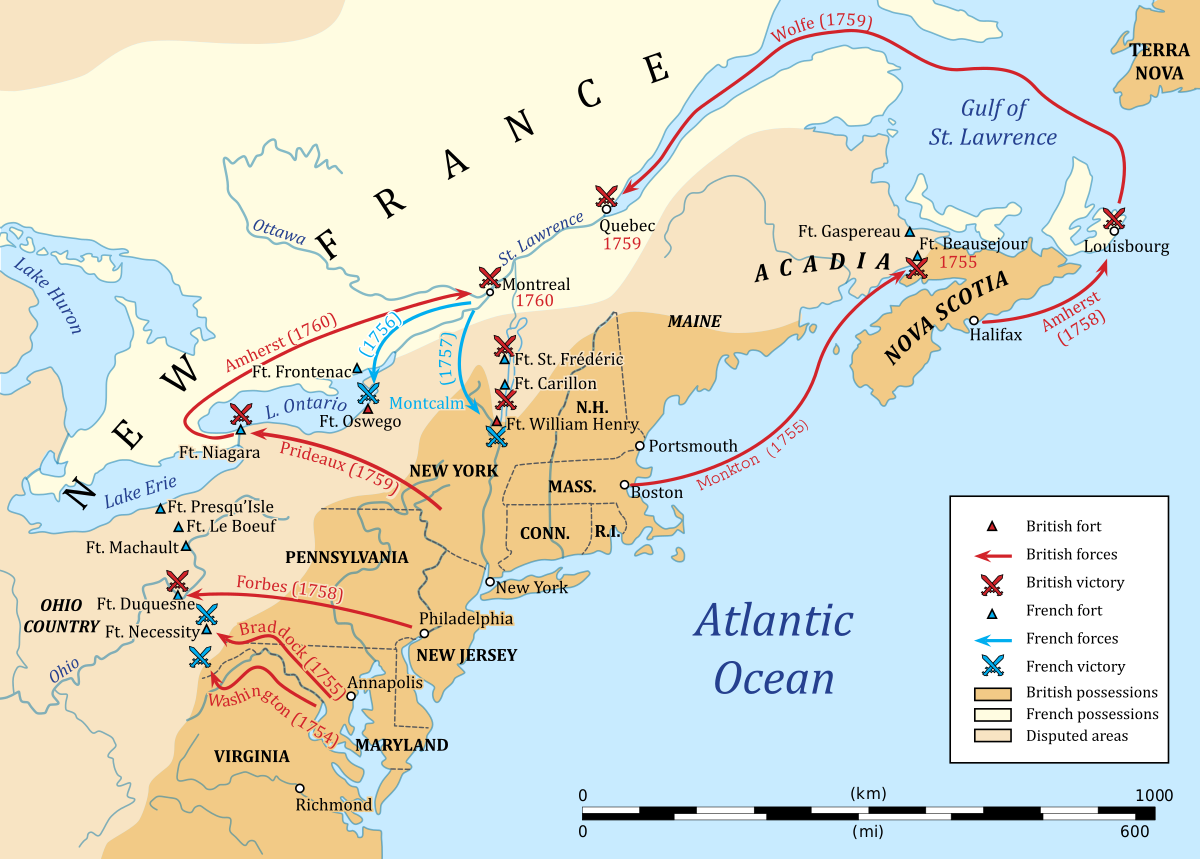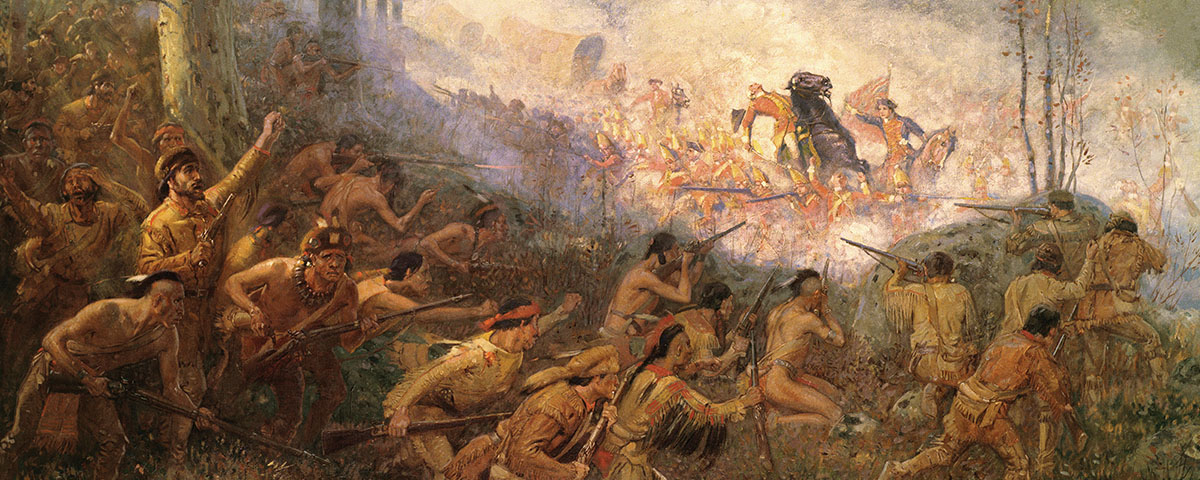XVII and XVIII Centuries
The struggle of New France against British expansionism.
In North America, in the Great Lakes and the San Lorenzo basin areas, virgin forests separated the French and English colonies. At first, only the Aborigines dared to enter and pass through them. Soon, the French, especially the trappers, acquired the necessary capabilities for this activity. The English and their colonists could not even appreciate the difficulties of the march for them: Uneven and rocky soils, hidden by slippery fallen and overlapping leaves and strangely tangled weeds; which were hindered every few steps by fallen rotting trees. These primitive forests soon became a military means of great value. For an armed light force, able to penetrate and cross them in their hidden approach to the enemy. Doing not very long marches, which did not mean a wear on their marching and combat capabilities. Because no British soldier, no English settler was able to advance through them, nor fought in that vast territory of anyone.

The key to the comfortable survival of New France in the face of the demographics and appetites of the English was thus found, little by little. Irregular fighting tactics in attack and defense were adapted and implemented and gradually refined. This gave the French regulars and their Canadian militias an advantage in operational strategy.
And, as a corollary, they gained clear control over the fur trade and enormous influence over the Iroquois tribes.
We must now confirm that the French counted soon with the collaboration and loyalty of the Indians. Those whom the French approached and attracted for their defense, with far more diplomacy and skill than the British. These treated them as «isolated» and inferior and the French acted as friends and collaborators. It was probably influenced by the Jesuit priests and nuns, who came to New France, mainly from the measures of Louis XIV. That offered to everyone, as souls redeemed by Jesus, on the basis of charity and compassion, a treatment even testimonial of help and teaching, and also to the Iroquois. Far from the mercantilist sentiments and the idea of God’s blessing to the English’s own material progress.

As a detail, some Jesuits frequently went as chaplain on the expeditions to attack the English settlements and groups. And, some of the first Indian revolts against the English, after the Seven Years’ War, were due to the fact that they abruptly suspended the usual and generous annual gifts of the French to the Indians chiefs and tribes.
The bordering forests were crossed by a good hydrographic network, even capillary in some places, whose knowledge by the French and the Indians allowed them to advance more quickly and comfortably through their different regions, using the country’s canoes. These incursion marches, sometimes by hundreds of assailants, demanded the establishment of various «logistics stations» (hubs) for the assembly, unloading and storage of equipment and supplies and repair workshops and with temporary bases for the men.
The Resistance of New France.
The rest of the 18th century was marked by an intermittent struggle of the French, Canadians and their Indian allies for survival, facing the threat of the English neighbors and their colonists.

The offensive tactics and techniques of the French raiders were the ambushes prepared against the advancing enemies. And the surprise assaults on British and Anglo-American settlements of all kinds. After previously reconnaissance the objectives and checking their means and routines.
They took advantage of the concealment of the night, the fog or the rain to attack them from a couple of concentric directions, eliminating each attack group (the Indians went alone) the enemy resistances of the different constructions. And plundering them and taking prisoners. The Indians were in the habit of taking «trophies» from enemies, to exchange or display them later. Which the French soon banned and cut off.
The English hardly ever deployed a security in their positions, even if they expected an enemy attack. The physical capacity for combat of the attacked was generally low. After the attacks, survivors or escapees alerted their nearby positions to send their militias to counter-attack the French. However, the persecutors were not very effective either in reaching the retreating attackers or in combat with them. And, many times they were ambushed by these, who took advantage of favorable points and/or covered and camouflaged in their approach.
French irregulars deployed in attacking groups of 30 to 50 men. Although their various groupings march through the forests towards an important goal, could reached several hundred of their combined forces.

The English never had the slightest intention of undertaking an effective, costly, extensive, deep and sufficient training of their regulars and colonists in irregular fighting in wooded terrain. That was for them an insurmountable impediment to their transitability to the French settlements.
The English naval attacks, supporting with their heavy fire of board, and amphibians, to land troops and to avoid the crossing of the forests, were always effective. But, they were not used, except in the final war for the domination of North America, for the lack of means and logistical complications. And they were effective because in them the French lost their irregular infantry fighting capabilities and the favorable transitability of the terrain from march to combat. And so, they had to defend themselves symmetrically against a much more powerful and mobile regular enemy, with naval capacities.
New France is lost in the 7-year war.
In 1754, at the beginning of that global and imperial war for the domination of the known and relevant world, the population of New France reached 55 thousand inhabitants and that of the English colonies to the south was 2.4 million people.

Both France and Great Britain then moved large contingents of regular forces to North America. Which allowed the English to force a regular form of fighting. And, with the invasion of New France, at its most important and vulnerable points, by land and sea, finally prevailed to France and its colonists in the American theater of the World War.

One of the peak actions of irregular warfare in that theater was the Battle of Monongulela, on 9 June 1755. When the British regular column of General Braddock was annihilated (unable to fight for their casualties and loss of morale) by the French irregulars in a prepared ambush in their march through the forest. The French were 30 and their Indian allies, 300.
(THE END)